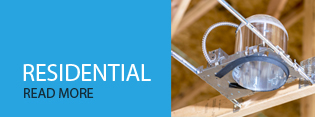FAQ
Q) When do I need a permit?
A) Permits are needed anytime something new will be added to your home or business. Some examples would be putting and addition on your home, remodeling a kitchen or bathroom, installing a new hot water heater or furnace. This can be confusing, for example, if you need to have a switch or outlet replaced in your home that is defective…you do not need a permit to have it replaced, same goes for existing light fixtures or ceiling fans. But, even if you have an existing hot water heater, or furnace and are just simply replacing it, you do need a permit. If you’re not sure, get in contact with a licensed electrician or call you town permit department. REMEMBER: What may seem like a nuisance of unnecessary paper work is actually in place to protect “you” the customer.
Q) Can I save energy by changing the light bulbs I use?
A) Yes by switching to an LED, Compact Fluorescent (CFL) bulb or even halogen, you can save energy, but be aware there is an initial cost involved as these more energy efficient bulbs are more expensive than a regular light bulb, but the return will be much greater in the long run.
Q) When should I change the batteries in my smoke detectors?
A) Even if your smoke detector is not reminding you to change the battery with an annoying beep; you should still change all the batteries in all smoke detectors in your home on a yearly basis.
Q) Why won’t my smoke detector stop beeping?
A) ) Your smoke detector will normally beep for 2 reasons, 1st try changing the battery to a known fresh battery. 2nd If it still doesn’t stop beeping, remove the detector from the ceiling or wall and locate the “manufacture date” or “replace by date” printed on the back, normally 7-10 years from when it was manufactured, it will not stop beeping if it needs to be replaced because it is too old.
Q) Are LED or Compact Fluorescent (CFL) bulbs as bright as a regular light bulb?
A) Yes, if you choose the correct one, when choosing an energy efficient bulb no matter what type, first look at the bulb you have, locate the amount of lumens that this bulb gives out not the wattage, lumens is brightness and wattage is energy. Then look for an energy efficient bulb with lower wattage but similar lumens to your original bulb. HINT: You may have to look on the packaging to locate the lumens.
Q) Why do LED and Compact Fluorescent (CFL) bulbs seem to be different colors, and how to I choose the right one for me?
A) All bulbs no matter what type, appear to be give off a slightly different color. These colors are measured on a temperature scale that is referred to as (K) or Kelvin. This scale ranges from 1000k up to 10,000k. 1000k or the lower end of the scale is similar to the color of candle light, whereas 10,000k at the upper end of the scale is most similar to blue sky daylight. Incandescent bulbs or soft white bulbs are about 2700K, if you like pure white light, you’re looking for about 3000-3500K. This is often why people go shopping and they see a bulb marked “Day Light” and they think this is what they want, so they bring it home and are unhappy because it appears blue because they are at a range of 6000-6500K.
Q) I changed some of my light bulbs to LED or fluorescent and now my dimmer won’t work?
A) 1st you must change all bulbs that are on the dimmer to the same type of bulb. 2nd If you have chosen compact fluorescent and have changed all bulbs…two things could be happening the bulbs you have chosen are not dimmable, or the dimmer you have is outdated and cannot work with LED or CFL bulbs and it need to be upgraded.
Q) How do I test my GFCI outlet in my kitchen or bathroom?
A) There are two buttons on the front of the GFCI outlet, one labeled “test”, and the other labeled “reset”. To test the GFCI outlet push the test button and you should hear a “click” and see the reset button pop out a bit, then press the reset button and you should again hear a “click” and power should be restored to the outlet, if the GFCI outlet cannot be tested in this manner it needs to be replaced.
Q) Why does my extension cord get hot?
A) The extension cord you are using gets hot simply because you are asking too much of it. There are two main reasons involved here…1st you may have too much plugged into it, or what you have plugged in to it needs too much power. 2nd the extension cord is too long. The bigger the item, appliance, or tool being plugged in, or the longer the distance; means you need a heavier gauge extension cord. Utilize the chart that comes on the back of the packaging to choose the correct extension cord.
Q) Can I use an extension cord to plug in my refrigerator, air conditioner, or heater?
A) Yes, however, it is best to just simply plug the appliance in using only the cord that comes with the appliance. It may be possible to relocate the appliance to be close to an outlet or have an outlet installed just for that purpose. If you must use an extension cord, use the shortest length possible, they make appliance extension cords specifically for this purpose starting at about 3’ up to 15’. Also take a very close look at the cable on your appliance it should give you the gauge of the wire 16/3, 14/3, 12/3 be sure to choose one of equal or greater value, and don’t be confused, the smaller the number the bigger the wire. TIP: Make sure it is a grounded extension cord or use the proper adaptor and never remove the ground pin to make it fit in to the outlet, and always avoid running any extension cord under carpets or rugs.









